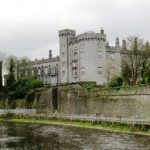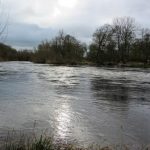
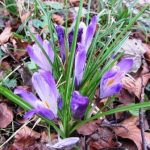
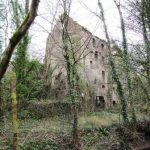
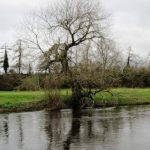
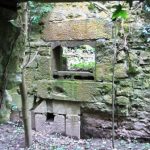
There are few rivers as diverse and exciting as the Nore in its course between Bennettsbridge and Kilkenny – at one moment flowing slow and stately at ambling pace, the next minute charging round a bend in a flurry of white horses, or seething loudly down the lumps and bumps of derelict mill weir with enough force and commotion to drown anyone unlucky enough to tumble in.
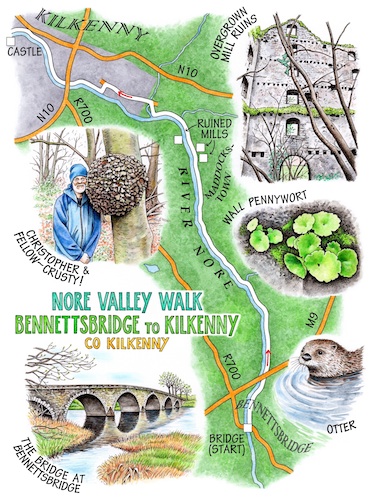
The Nore can abruptly rise, too, flooding the adjacent meadows in quick time.
Near Bennettsbridge the river flows through a flattish part of Co. Kilkenny, green countryside with a gentle roll to it. The handsome stone curve of the little town’s seven-arch bridge has withstood the rages and tempers of the Nore for some 250 years. We stood admiring it, looking through the arches to the tall old mill that houses Nicholas Mosse’s pottery. Evidence of recent floods lay all around – thick stands of rushes with their feet in fleets of water out in the middle of the meadow, and a draggle of sticks and straws caught high in the willow branches beside the river.
We walked upstream against the river’s flow, watching a cormorant hurrying up the valley like a black torpedo bomber, following the line of the Nore. The water slipped silently by, the colour of tarnished copper, carrying twigs, strings of bubbles and nonchalantly sailing mallard drakes. Under the swish and thump of the M9 bridge and on in a tunnel of hawthorns where long-tailed tits flirted their sterns and a chaffinch with a brilliant rose-pink breast sidled down a branch before flying off. Half-fallen willows leaned long pale arms into the water, as if for support.
‘Good God,’ Jane called out suddenly, ‘what’s that?’ A heavy splash into the river right under our feet was followed by the appearance of a sleek brown back, curving like a dolphin’s before vanishing. ‘Otter!’ A neat round head emerged a little way upriver. The otter swam ahead of us along the bank, pushing a bow-wave in front, then ducked into a tangle of vegetation. Out flew three mallards, quacking in terror. We stood stock still, but the otter had gone to ground. An episode that you could never plan for, the kind of moment that leaves a sweet taste in the mouth and a flutter in the senses.
Letting out our breath and grinning like lottery winners, we walked on through riverside woods where daffodils were just pushing their yellow crinkly flowers out from tight green buds. Celandines were beginning to show shiny yellow stars among the ground ivy, and we passed a solitary clump of crocuses whose long purple petals lay half open to give a glimpse of a brilliant orange stigma far down in the long throat of each flower. A pair of kingfishers darted out from an overhang of the river bank and sped downriver in twin flashes of electric blue.
Rock faces of the famous Kilkenny marble formed walls like railway cutting sides between which the Nore began to race and bounce down a succession of broken weirs. This powerful stretch of the river was very heavily used by water mills in times past – some drove the machinery that cut the marble ready for the polishers, others ground corn or made paper. We passed their skeleton hulks, one after another, blank windows rising six storeys high, walls tottering, roofs long gone, stones squared and grooved by nameless millwrights to hold the long-forgotten machinery that ground, cut and sawed out Kilkenny’s industrial prosperity for several centuries. Now the Nore mills stand lost like fairytale castles, each in its own enchanted thicket.
Nearing Kilkenny, I spied a piece of graffiti that revealed a dark secret. Naughty Dylan woz ‘ere with Becca – but also, on another occasion, with Ruth. Both girls luvd Dylan. Bit of a tangle to sort out there, my rash friend.
The view ahead showed a foaming weir laden with trees dumped along its lip by floods on the Nore. Above it rose the houses of Kilkenny. It was the end of one of the most delectable river walks in Ireland, an unfolding tale of kingfishers, otters, Sleeping Beauty castles and wicked young princelings – pure distillation of magic in the floodlands of Kilkenny.
WAY TO GO
MAP: OS of Ireland 1:50,000 Discovery 67; downloadable map/instructions, apps etc from trailkilkenny.ie.
TRAVEL: Rail (irishrail.ie) or bus (buseireann.ie) to Kilkenny. Road: M9 Jcts 8 or 9, N10 to Kilkenny. On to Bennettsbridge – Kilbride Coaches (051-423633); R700 by car; taxi 1850-444546.
WALK DIRECTIONS: In Bennettsbridge, down steps beside Tynan’s Butcher; turn right along River Nore, following green arrows. Nearing Kilkenny, join road for short section, then back to river. Under N10 and on into Kilkenny. Continue down Maudlin Street; at end, left down John Street. Cross river; up Rose Inn Street to Kilkenny Castle.
LENGTH: 12 km/7 ½ miles – allow 3 hours
GRADE: Easy
CONDITIONS: Well-marked footpath
DON’T MISS:
18th-century, 7-arch bridge at Bennettsbridge
Romantic, tumbledown mills on the Nore
Wildlife – bring binoculars (otters, kingfishers, etc).
REFRESHMENTS: Zuni, Patrick Street (056-772-3999) – one of Kilkenny’s best restaurants; try their roast rabbit and the squid and chorizo salad.
BEST PICNIC SPOT: By the Nore mills
ACCOMMODATION: Pembroke Hotel, Kilkenny (056-778-3500; kilkennypembrokehotel.com; from 79 euros dble B&) – delightful, friendly boutique hotel right in the centre of Kilkenny.
WALKING in IRELAND: Walking tour operators, local walks including Discover Ireland’s National Loop Walks, walking festivals throughout Ireland: www.discoverireland.ie/walking.
Slieve Bloom Walking Festival, Co Laois: 4-7 May (087-774-9281; 086-821-0056; www.slievebloom.ie)
KILKENNY TOURIST OFFICE: 056-775-1500; southeastireland.com
TRAIL KILKENNY: 056-775-2111; www.trailkilkenny.ie
